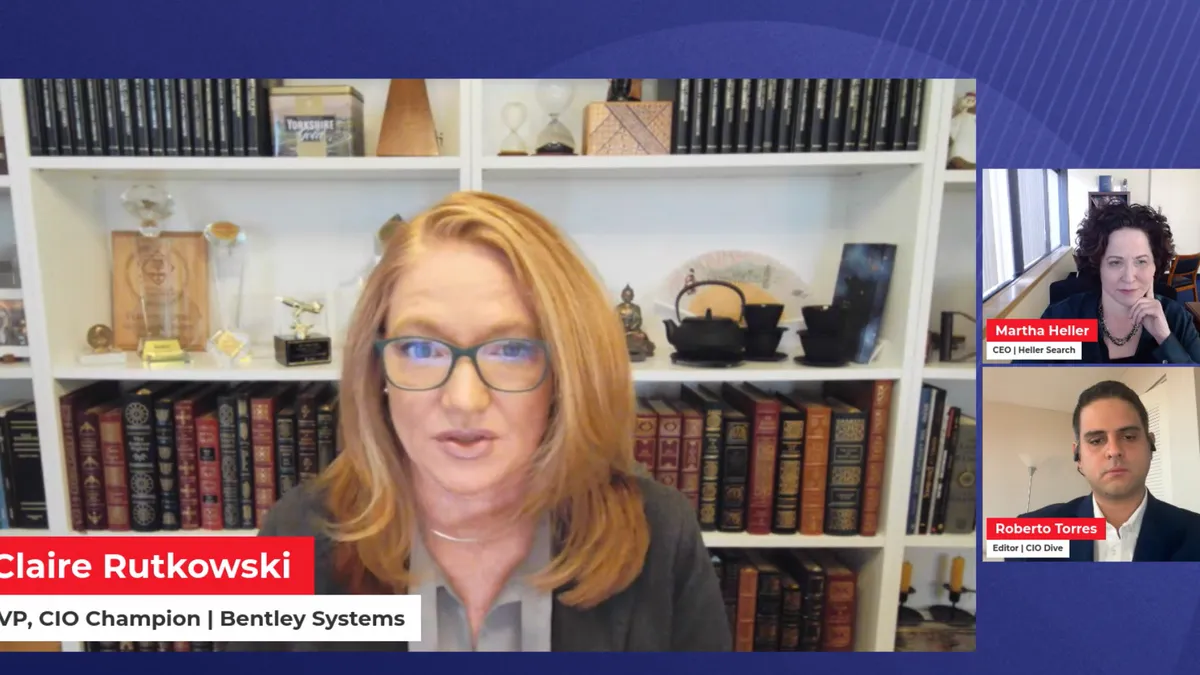Editor’s note: This article draws on insights from a CIO Dive virtual event panel. You can register here to watch a replay of the full event, “What Technologies Will Win — and Lose — in 2024,” here.
Even in the face of notable layoffs within the technology sector earlier this year, enterprise appetite for technologists has only ballooned.
“I would use three adjectives to describe hiring in technology in 2023, and that’s: hot, hot and hot,” said Martha Heller, CEO of Heller Search, during a CIO Dive live virtual event last week.
Organizations across industries are relying more on technology now than they did before, resulting in increased competition for top tech talent. Generative AI interest played a part as well, pushing organizations to rethink existing plans and pivot to embrace the technology, though many companies still struggled to address skills gaps.
Heller’s organization, which primarily sources technology leaders for enterprises, has had a front-row seat to the struggles organizations go through to find skilled decision-makers and tech talent.
“We were delighted when we brought a candidate to our client who didn’t already have a competing offer,” Heller said.
Skills gaps plagued enterprises this year, underscoring the need for knowledgeable workers and leaders to execute initiatives. Heading into the new year, enterprises are poised to encounter familiar challenges that persisted throughout 2023.
1. Rethink where work happens
Mandated return-to-office policies can prevent an organization from drawing topflight talent.
“People expect and demand flexibility these days,” said Claire Rutkowski, SVP and CIO Champion at Bentley Systems. “Expecting everyone to come into the office five days a week just doesn’t work anymore.”
Without a hybrid or remote work plan, businesses limit their talent search to a 30-mile radius of where offices are located, Rutkowski said.
Around 90% of companies plan to implement return-to-office policies by the end of 2024, according to an August report from Resume Builder. It is a shift that most technologists are trying to avoid — at least in part.
More than half of IT workers said they prefer a hybrid schedule, while more than one-third desired to stay remote, according to Skillsoft research published this week. Just 11% wanted to only work in an office setting.
Heller said clients often want technology leaders to come to the office five days a week.
“Sometimes we were able to satisfy their relocation requirements," Heller said. "But more often than not we found companies actually defining their hybrid or remote work strategy based on the fact that they couldn’t get talent unless they were to allow for quite a bit of remote work."
2. Hunt for AI-related skills
Experts believe the growing interest in adopting generative AI will have an outsized impact on talent strategies.
Organizations are on the hunt for workers who can propel the organization toward successful deployment of the technology, leading to more related job postings, increased salaries and attention toward skills that support the tech.
The average listed salary for an AI engineer grew 12% in Q3 of this year, resulting in an average annual salary of around $188,000 or 21% higher than non-AI software engineers, according to data from Comprehensive.io.
“Large language model engineers, prompt engineers and any kind of AI experience is going to be highly sought-after,” Rutkowski said.
Job postings associated with AI reached 12% of all tech roles posted in November, according to a CompTIA review of U.S. Bureau of Labor Statistics data. It was the first time AI-related job postings cleared the 10% threshold in the trade group’s analysis.
But it’s not just AI-specific skills that are expected to become more in-demand in the new year. For the technology to work, organizations need clean, accessible data, infrastructure upgrades and workers who can manage the systems.
“What AI has forced companies to do is get a real handle on what their data assets actually look like, and more often than not it’s data, data everywhere but not a drop of value,” Heller said.
3. Connect to the mission, culture
Upskilling existing workers is just as important as acquiring skilled talent. Each organization has its own mission and priorities that can draw in skilled talent and keep them around, but organizations have to be able to communicate those goals.
“You can attract talent by being very clear about your mission and your purpose,” Rutkowski said. “[For] folks just coming out of school or just finishing their training and getting into the workforce, that mission and purpose is really important to people.”
Companies can’t just say they care about diversity and inclusion, they have to be able to show it, Rutkowski said. This becomes even more critical for enterprise workforce strategies as competition grows.
CIOs can play an important role by connecting workers to the mission and culture.
“You can get them in with the mission, but retain them by creating a connection to that mission,” Heller said. Heller expects companies to ramp up partnerships with universities as a way to build a pipeline of skilled data scientists.
"Attracting technologists who will only be interested in the latest and greatest technology is increasingly becoming a business strategy,” Heller said. “Sometimes you invest in technology as a talent and acquisition strategy.”






















